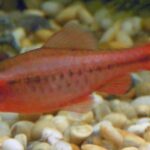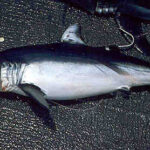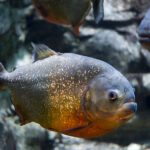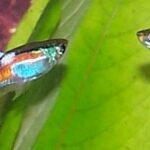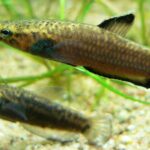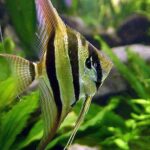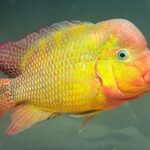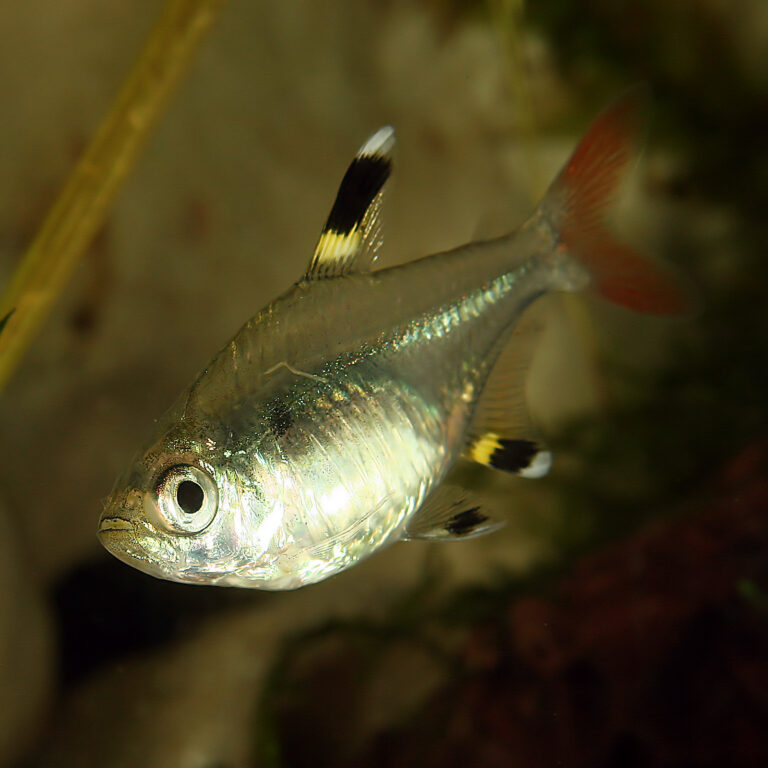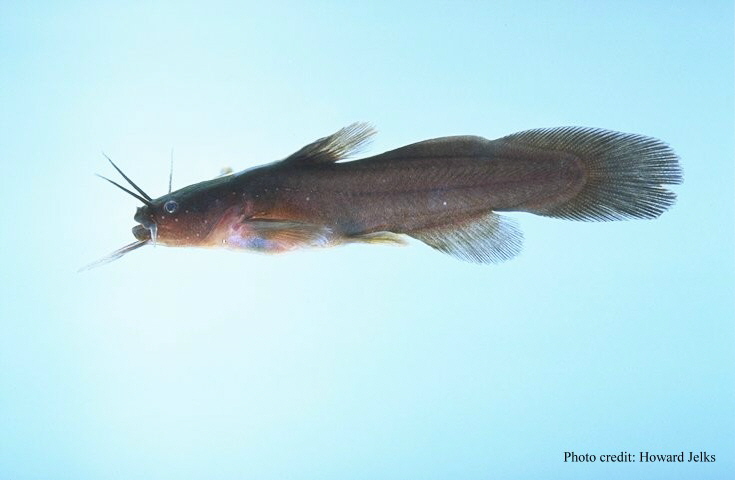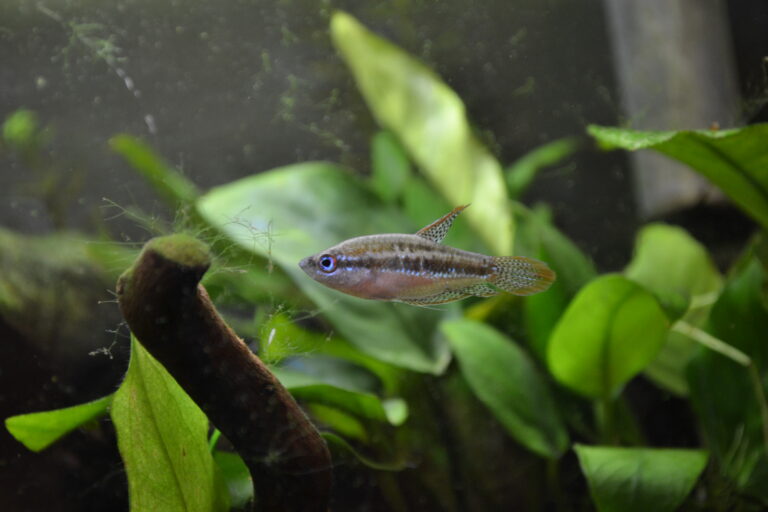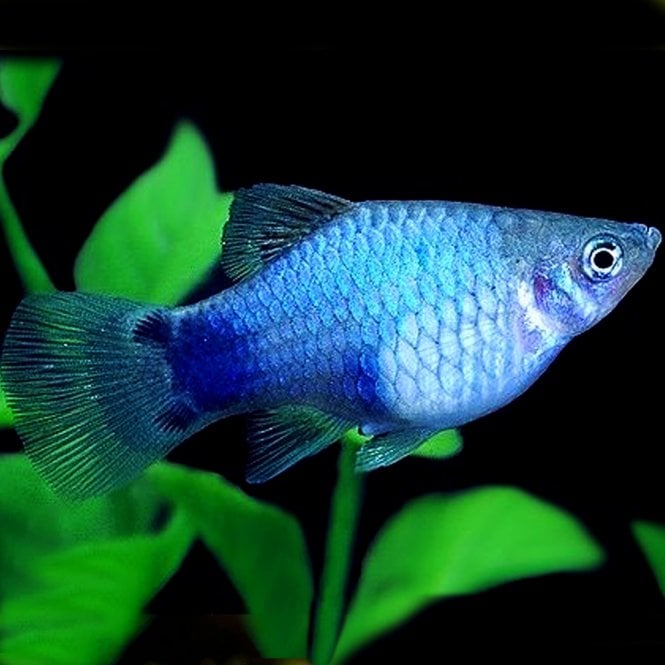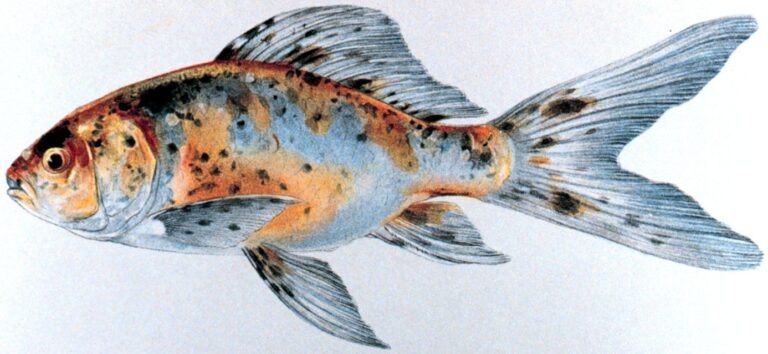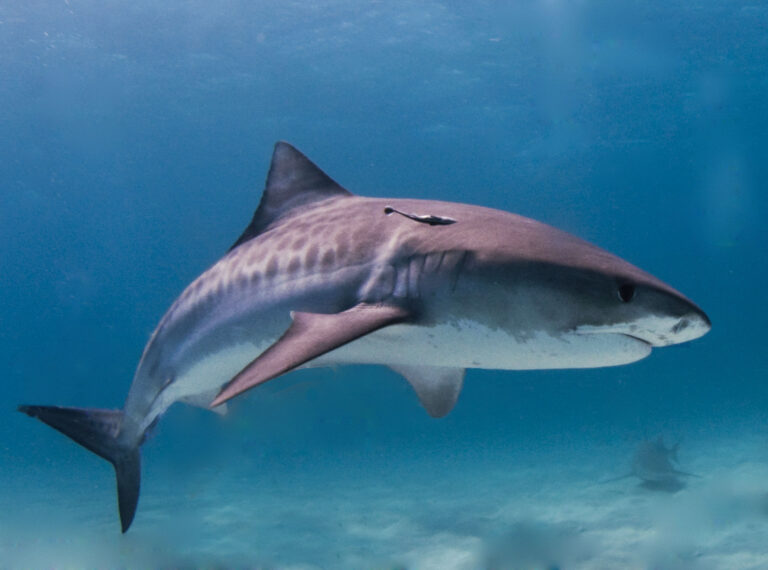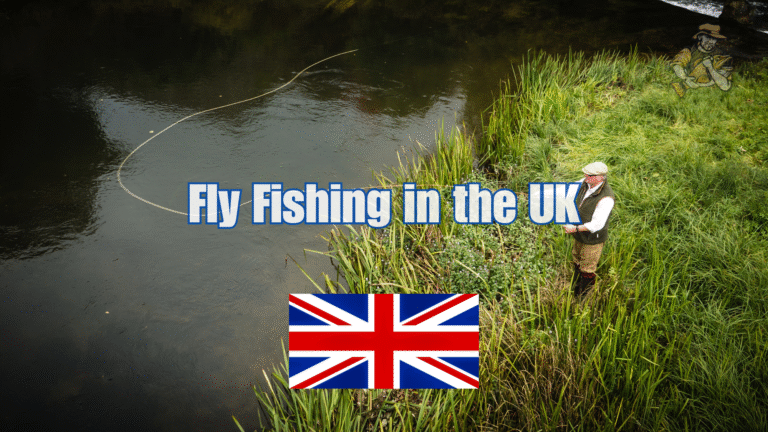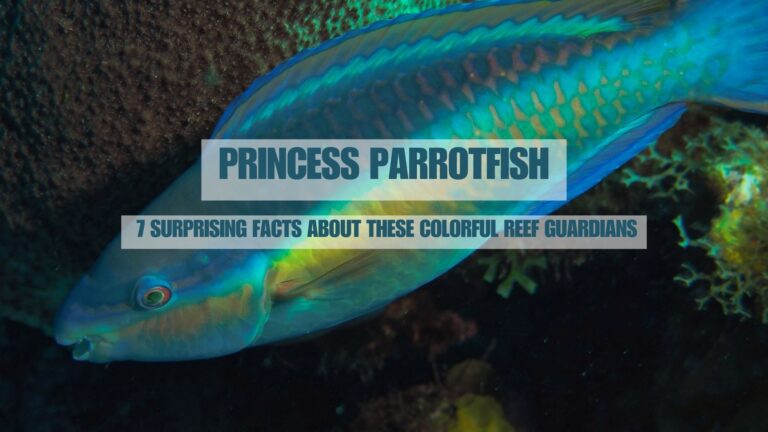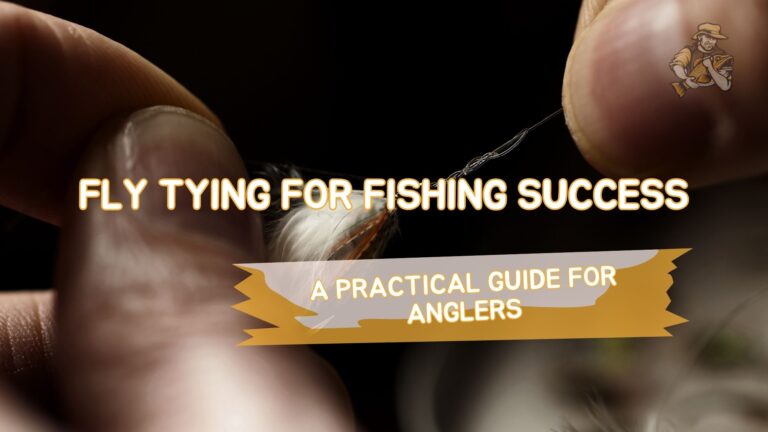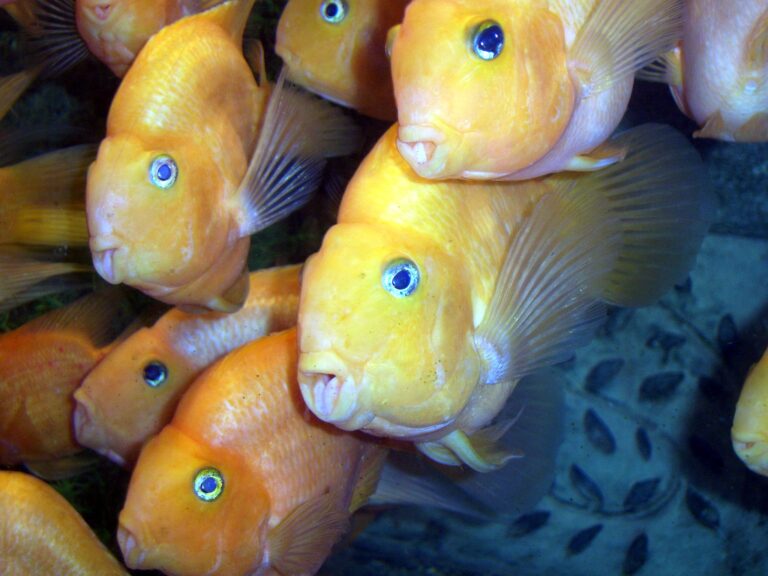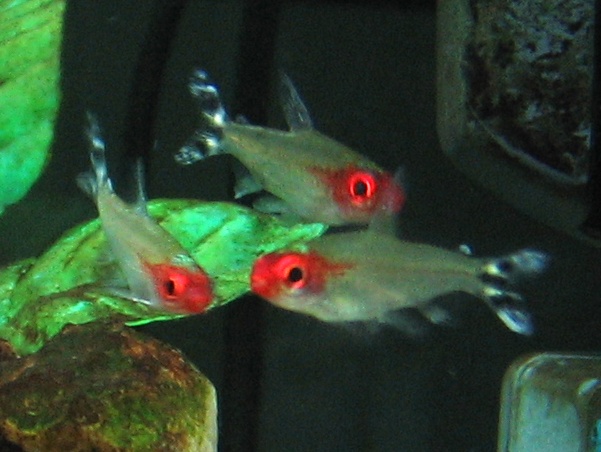Marigold Swordtail
By Ryan Maron | Last Modified: June 12, 2025

The Marigold Swordtail (Xiphophorus hellerii var. marigold) stands as one of the most vibrant and sought-after color variants within the freshwater aquarium trade. This selectively bred variety of the common swordtail displays brilliant golden-orange coloration reminiscent of marigold flowers, combined with the characteristic elongated caudal fin extension that defines the species. Beyond its ornamental appeal, the Marigold Swordtail serves as an important model organism for genetic research and represents the successful application of selective breeding techniques in aquaculture. These hardy livebearers play crucial ecological roles in their native Central American freshwater systems, functioning as both predators of smaller invertebrates and prey species for larger fish, while their adaptability has made them valuable indicators of aquatic ecosystem health.
| Feature | Details |
|---|---|
| Common Name | Marigold Swordtail |
| Scientific Name | Xiphophorus hellerii var. marigold |
| Family | Poeciliidae |
| Typical Size | 8-15 cm (3-6 inches), 15-35 grams |
| Habitat | Freshwater streams and rivers |
| Diet | Omnivorous – insects, algae, plant matter |
| Distribution | Central America, worldwide in aquaculture |
| Conservation Status | Least Concern |
Taxonomy & Classification
The Marigold Swordtail belongs to the family Poeciliidae, commonly known as livebearers, within the order Cyprinodontiformes. The genus Xiphophorus, derived from Greek words meaning “sword bearer,” encompasses approximately 28 recognized species native to North and Central America. Xiphophorus hellerii was first scientifically described by Karl Theodor Heckel in 1848, with specimens collected from Mexican river systems.
The marigold variety represents a selectively bred color morph rather than a distinct subspecies, developed through decades of aquaculture breeding programs. Genetic analysis reveals that the characteristic golden-orange coloration results from the interaction of multiple pigment genes, including erythrophore and xanthophore expression patterns. The breeding lineage traces back to wild-type green swordtails collected from the Rio Nautla and Rio Panuco river systems in Mexico.
Modern taxonomic classification places the Marigold Swordtail within a complex of closely related Xiphophorus species that readily hybridize in captivity. Molecular phylogenetic studies using mitochondrial DNA markers have confirmed the species’ position within the northern swordtail clade, sharing common ancestry with X. clemenciae and X. montezumae approximately 2.5 million years ago.
Physical Description
The Marigold Swordtail exhibits striking sexual dimorphism characteristic of the Poeciliidae family. Males typically reach 10-12 centimeters in total length, featuring the iconic sword-like extension of the lower caudal fin rays that can add an additional 3-5 centimeters to their overall length. This sword structure consists of elongated fin rays supported by modified lepidotrichia, creating a distinctive pointed projection that serves both courtship and species recognition functions.
The marigold coloration manifests as brilliant golden-orange hues concentrated across the body’s lateral surfaces, with intensity varying based on environmental conditions and genetic background. Chromatophores containing carotenoid pigments produce the characteristic warm tones, while underlying iridophores create subtle metallic sheens under proper lighting conditions. Males display more vibrant coloration than females, particularly during breeding periods when hormonal changes intensify pigment expression.
Female Marigold Swordtails grow larger than males, reaching 12-15 centimeters in length with more robust body profiles adapted for egg development and live birth. They lack the sword extension but retain the golden coloration, though typically less intense than their male counterparts. Both sexes possess relatively large eyes adapted for visual predation and conspecific recognition, with well-developed lateral line systems for detecting water movement and potential threats.
The dorsal fin contains 12-14 rays in both sexes, while the anal fin in males develops into a gonopodium – a modified reproductive structure containing 9-10 rays formed into a tube-like organ for internal fertilization. This adaptation represents a key evolutionary advancement that distinguishes livebearing species from their egg-laying relatives.
Habitat & Distribution
Wild-type swordtails, from which Marigold Swordtails derive, inhabit freshwater systems throughout eastern Mexico and northern Central America. Primary distribution encompasses river basins from the Rio Panuco in northern Mexico southward to northwestern Honduras, including major watersheds such as the Rio Grijalva, Rio Usumacinta, and Rio Coatzacoalcos.
Natural habitats consist of slow-moving to moderate-flow freshwater streams, rivers, and associated backwater areas with abundant vegetation. Water parameters in native environments typically range from 22-28°C (72-82°F), with pH values between 7.0-8.5 and moderate hardness levels of 10-25 dGH. Dissolved oxygen concentrations remain consistently high due to flowing water and photosynthetic activity from aquatic plants.
Substrate composition varies from rocky cobble in faster-flowing sections to soft sediments in quieter pools and eddies. Dense riparian vegetation provides crucial shade and terrestrial insect input, while submerged and emergent aquatic plants offer shelter, spawning sites, and food resources. Water depth preferences range from shallow margins of 10-20 centimeters to deeper pools reaching 2-3 meters.
The Marigold Swordtail variety has achieved global distribution through the aquarium trade, with established populations now present across tropical and subtropical regions worldwide. Introduced populations have been documented in freshwater systems throughout Southeast Asia, Australia, and parts of the southern United States, though their ecological impact remains variable depending on local conditions and native species assemblages.
Captive breeding has adapted these fish to a broader range of water conditions than their wild ancestors, demonstrating remarkable physiological plasticity that contributes to their success as aquarium species and potential invasives in suitable climates.
Diet & Feeding Behavior
Marigold Swordtails exhibit omnivorous feeding patterns that reflect their adaptability to diverse aquatic environments. Their diet encompasses both plant and animal matter, with composition varying seasonally based on resource availability and reproductive demands. Microscopic examination of gut contents from wild specimens reveals approximately 60% plant material and 40% animal protein under typical conditions.
Primary food sources include filamentous algae, diatoms, and detrital organic matter scraped from substrate surfaces and vegetation. Specialized pharyngeal teeth allow efficient processing of fibrous plant materials, while forward-pointing oral teeth capture small invertebrate prey. Feeding behavior typically occurs during daylight hours, with peak activity observed during early morning and late afternoon periods.
Animal protein sources consist primarily of small invertebrates including chironomid larvae, copepods, ostracods, and emerging aquatic insects. During reproductive periods, females increase protein consumption to support egg development and fry production. Territorial males often display aggressive feeding behaviors, monopolizing prime foraging locations and food resources.
Feeding strategies demonstrate considerable behavioral flexibility, with individuals adapting techniques based on food type and environmental conditions. Surface feeding occurs when terrestrial insects fall into the water, while bottom foraging involves systematic searching through substrate and vegetation. Swordtail feeding patterns show remarkable consistency across different color varieties, suggesting that selective breeding for appearance has not significantly altered basic behavioral traits.
Juvenile Marigold Swordtails consume proportionally more protein than adults, with diets consisting of up to 70% small invertebrates including rotifers, nauplii, and microscopic crustaceans. This higher protein requirement supports rapid growth rates and development during the critical first months of life.
Behavior & Adaptations
Marigold Swordtails display complex social behaviors centered around hierarchical structures and reproductive activities. Males establish territories through aggressive displays and physical confrontations, with dominant individuals securing prime habitat areas containing optimal feeding and breeding sites. Territorial boundaries fluctuate based on population density, resource availability, and seasonal reproductive cycles.
Schooling behavior varies with age and environmental conditions, with juveniles forming loose aggregations for protection while adults tend toward more solitary lifestyles except during breeding periods. Mixed-species associations frequently occur in natural habitats, particularly with other Poeciliidae species sharing similar ecological requirements.
The species demonstrates remarkable physiological adaptations for live birth, with females capable of storing sperm for multiple breeding cycles following a single mating event. This superfetation ability allows overlapping generations of developing embryos within the female’s reproductive tract, maximizing reproductive output in favorable conditions.
Swimming patterns reflect their streamlined body design and active lifestyle, with sustained swimming speeds averaging 3-4 body lengths per second during normal activity. Burst swimming capabilities reach 10-12 body lengths per second when escaping predators or during aggressive encounters between males.
Environmental adaptations include tolerance for moderate salinity levels, allowing temporary survival in brackish conditions during seasonal flooding events. Behavioral thermoregulation involves seeking specific temperature microhabitats, with individuals moving between shallow warming areas and deeper cool zones throughout daily cycles.
Stress responses include color changes, altered swimming patterns, and modified feeding behaviors. Chronic stress can suppress the characteristic marigold coloration, leading to pale or mottled appearance until favorable conditions return. These adaptations contribute significantly to the species’ success in both natural and captive environments.
Reproduction & Life Cycle
The Marigold Swordtail follows a live-bearing reproductive strategy characteristic of the Poeciliidae family, with internal fertilization and direct development of embryos within the female’s body. Sexual maturity occurs at approximately 3-4 months of age, coinciding with the development of secondary sexual characteristics including the male’s sword extension and gonopodium formation.
Mating behavior involves elaborate courtship displays by males, featuring lateral body presentations, fin erection, and zigzag swimming patterns designed to attract female attention. Successful males approach females from below and behind, using the gonopodium to transfer sperm packets during brief copulatory events lasting 2-3 seconds.
Gestation periods range from 24-30 days depending on water temperature and female condition, with optimal development occurring at 24-26°C. Females can store viable sperm for 6-8 months, allowing multiple broods from a single mating event through a process called superfetation. This reproductive strategy ensures continuous offspring production even when males are scarce or environmental conditions limit mating opportunities.
Brood sizes typically range from 20-80 fry per birth, with larger, more mature females producing higher numbers of offspring. Newborn fry measure approximately 6-8 millimeters in length and possess fully developed swimming and feeding capabilities immediately upon birth. The characteristic marigold coloration begins developing within 2-3 weeks as chromatophores mature and pigment production increases.
Parental care is minimal, with females showing no protective behaviors toward offspring after birth. Fry survival depends on available shelter, appropriate food resources, and absence of predation pressure. In optimal conditions, juvenile growth rates average 0.5-0.8 millimeters per week, reaching adult size within 4-6 months.
Environmental factors significantly influence reproductive success, with photoperiod, temperature, and nutrition affecting breeding frequency and offspring quality. Extended daylight periods and stable warm temperatures promote year-round reproduction in suitable climates, while seasonal variations in temperate regions concentrate breeding activities during warmer months.
Predators & Threats
Natural predators of Marigold Swordtails include a diverse assemblage of aquatic and semi-aquatic species throughout their native range. Larger fish species such as bass (Micropterus spp.), pike (Esox spp.), and various cichlid species represent primary aquatic threats, particularly targeting juvenile and sub-adult individuals. The bright coloration of marigold varieties may increase predation risk compared to more cryptically colored wild-type swordtails.
Avian predators play significant roles in natural population regulation, with species such as kingfishers, herons, and cormorants actively hunting swordtails in shallow water areas. Wading birds pose particular threats during low water periods when fish become concentrated in reduced habitat areas. Terrestrial predators including snakes, frogs, and small mammals occasionally capture individuals during surface feeding activities or when fish become stranded in isolated pools.
Introduced predatory species represent growing conservation concerns in areas where swordtails have been established outside their native range. Non-native bass species, in particular, can dramatically reduce swordtail populations through intensive predation pressure, while invasive crayfish species compete for food resources and prey upon eggs and juveniles.
Environmental threats encompass habitat degradation, water pollution, and climate change impacts. Agricultural runoff containing pesticides and fertilizers can cause direct mortality and sublethal effects on reproduction and behavior. Urban development leading to increased sedimentation, altered flow regimes, and reduced water quality poses ongoing challenges to wild populations.
Disease pressures include various bacterial, viral, and parasitic infections that can cause significant mortality events, particularly in stressed or overcrowded populations. Common pathogens include Ichthyophthirius multifiliis, Columnaris bacteria, and viral hemorrhagic septicemia, though healthy populations typically maintain resistance through natural immune responses.
Human activities such as water extraction for agriculture and urban use can reduce habitat availability and fragment populations. Dam construction and flow modification alter natural habitat conditions, potentially affecting spawning success and juvenile survival rates in modified river systems.
Conservation Status
The International Union for Conservation of Nature (IUCN) currently classifies Xiphophorus hellerii as Least Concern due to stable wild populations and extensive distribution throughout its native range. However, this assessment applies to the species as a whole rather than specific color varieties such as the Marigold Swordtail, which exists primarily in captive breeding programs.
Wild populations demonstrate resilience to moderate environmental disturbances, though localized declines have been documented in areas experiencing severe habitat degradation or water quality deterioration. Long-term monitoring studies in Mexico indicate stable population trends across most of the species’ native range, with some watersheds showing increases due to habitat restoration efforts.
The extensive global aquaculture industry surrounding ornamental swordtails provides genetic insurance against potential wild population crashes, though captive breeding programs focus primarily on commercial varieties rather than wild-type genetic diversity preservation. Maintained breeding stocks ensure continued availability of the Marigold Swordtail variety regardless of wild population status.
Conservation challenges include increasing habitat fragmentation, agricultural intensification, and urbanization throughout Central American watersheds. Climate change projections suggest potential range shifts and altered precipitation patterns that could affect future population stability in marginally suitable habitats.
Ex-situ conservation efforts through aquarium breeding programs maintain diverse genetic lineages, though most commercial breeding focuses on aesthetic traits rather than genetic diversity preservation. Research institutions and public aquariums maintain wild-type breeding colonies to preserve natural genetic variation for potential future reintroduction programs.
International trade regulations under CITES do not currently apply to swordtail species due to their abundant populations and successful captive breeding. However, responsible aquarium trade practices emphasize captive-bred specimens to reduce pressure on wild populations and prevent introduction of diseases or genetic pollution.
Human Interaction
The Marigold Swordtail represents one of the most commercially significant ornamental fish varieties in the global aquarium trade, with millions of individuals produced annually through intensive breeding operations. Commercial breeding facilities throughout Southeast Asia, Eastern Europe, and the Americas specialize in producing consistent coloration and quality for international markets.
Aquarium hobbyists prize Marigold Swordtails for their vibrant appearance, hardy nature, and relatively simple care requirements. These characteristics make them ideal beginner fish while remaining popular with experienced aquarists for community tank displays and breeding projects. Their peaceful temperament and compatibility with platy fish varieties and other livebearers creates opportunities for diverse aquatic ecosystems.
Scientific research utilizing swordtails has contributed significantly to understanding genetics, evolution, and reproductive biology. The species serves as a model organism for studying sexual selection, with the male sword trait representing a classic example of ornamental evolution. Research on pigmentation genetics using various color morphs, including marigolds, has advanced knowledge of gene expression and developmental biology.
Educational applications include use in classroom settings for teaching basic biological concepts such as reproduction, genetics, and ecology. Many schools maintain breeding colonies to demonstrate live birth, heredity, and life cycles to students at various educational levels.
Economic impacts extend beyond direct sales to include related industries such as aquarium equipment, food production, and shipping services. The ornamental fish trade supports thousands of jobs worldwide, from small-scale breeders to large commercial operations and retail establishments.
Responsible ownership practices emphasize proper care, appropriate tank conditions, and prevention of accidental releases into natural water bodies. Education programs stress the importance of maintaining captive populations rather than collecting wild specimens, supporting conservation efforts while meeting aquarium trade demand.
Cultural significance varies regionally, with swordtails featuring in traditional practices and beliefs in some Central American communities. Their natural occurrence in sacred cenotes and cultural landscapes contributes to local identity and traditional ecological knowledge systems.
Interesting Facts
Marigold Swordtails possess the remarkable ability to change sex under specific environmental conditions, a phenomenon known as sequential hermaphroditism. When dominant males are removed from a population, some large females can develop male characteristics including gonopodium formation and sword extension, though this transformation requires several months to complete.
The characteristic sword of male swordtails continues growing throughout their lifetime, with some exceptional individuals developing extensions exceeding 40% of their body length. This continuous growth pattern differs from most fish fin structures, which typically reach fixed proportions during development.
Genetic research has revealed that the marigold coloration results from mutations in at least four different pigment genes, creating one of the most complex color inheritance patterns among aquarium fish species. Breeding for consistent marigold traits requires understanding of multiple genetic interactions and careful selection over several generations.
Wild swordtails can survive in water temperatures as low as 15°C (59°F) for short periods, demonstrating cold tolerance that exceeds most tropical fish species. This adaptability has contributed to their establishment in temperate regions where they might not be expected to survive.
The species exhibits lunar spawning cycles in some populations, with birth timing synchronized to specific moon phases. This behavior may relate to predator activity patterns or optimal environmental conditions for fry survival, though the exact mechanisms remain under investigation.
Marigold Swordtails can recognize individual conspecifics and maintain social memories for several weeks, allowing complex social relationships to develop within captive populations. Dominant males often remember previous encounters and adjust aggressive behaviors accordingly.
Archaeological evidence suggests that ancient Mesoamerican cultures maintained ornamental fish populations including early swordtail varieties, indicating human appreciation for these species extends back over 1,000 years. Clay vessels and artistic depictions from Mayan sites show fish resembling modern swordtail forms.
Laboratory studies have documented problem-solving abilities in swordtails, including navigation through simple mazes and association learning for food rewards. These cognitive capabilities exceed those of many fish species and contribute to their success in variable environments.
Frequently Asked Questions
How long do Marigold Swordtails typically live in captivity?
Marigold Swordtails generally live 3-5 years in well-maintained aquarium conditions, with females often outliving males due to less territorial stress. Optimal water quality, proper nutrition, and appropriate tank mates can extend lifespans, while poor conditions or overcrowding may reduce longevity to 2-3 years.
Can Marigold Swordtails breed with other swordtail color varieties?
Yes, Marigold Swordtails readily interbreed with other Xiphophorus hellerii color varieties, producing offspring with intermediate characteristics. However, crossing different varieties often results in less predictable coloration patterns and may dilute the distinctive marigold traits sought by breeders and hobbyists.
What water conditions do Marigold Swordtails prefer in aquariums?
Marigold Swordtails thrive in water temperatures between 22-28°C (72-82°F), pH levels of 7.0-8.2, and moderate hardness of 10-25 dGH. They require good filtration and regular water changes to maintain water quality, though they demonstrate tolerance for minor parameter fluctuations compared to more sensitive species.
How can aquarists distinguish between male and female Marigold Swordtails?
Males develop the characteristic sword extension on their tail fin and possess a gonopodium (modified anal fin) for reproduction, while females lack these features and grow larger with rounder body profiles. Additionally, males typically display more intense marigold coloration, particularly during breeding condition, making sex determination relatively straightforward in mature individuals.
Conclusion
The Marigold Swordtail stands as a testament to successful selective breeding while maintaining the hardy characteristics and fascinating behaviors of its wild ancestors. Its role in the aquarium trade, scientific research, and educational applications demonstrates the multifaceted value of well-managed ornamental fish varieties. Through responsible breeding practices and proper husbandry, this vibrant variety will continue contributing to both commercial aquaculture and our understanding of freshwater fish biology for generations to come.
Share The Article:
More Fish Species:
-
Bleeding Heart Tetra
The Bleeding Heart Tetra represents one of the most distinctive and peaceful freshwater fish species in the aquarium trade,…
-
Pristella Tetra
The Pristella Tetra (Pristella maxillaris) stands as one of South America’s most distinctive freshwater aquarium species, renowned for its…
-
Tadpole Madtom
The Tadpole Madtom (Noturus gyrinus) represents one of North America’s smallest and most elusive catfish species, playing a crucial…
-
Sparkling Gourami
The Sparkling Gourami represents one of the most captivating miniature freshwater species available to aquarium enthusiasts and serves as…
-
Blue Platy
The Blue Platy (Xiphophorus maculatus) stands as one of the most recognizable and culturally significant freshwater fish species in…
-
Shubunkin Goldfish
The Shubunkin Goldfish (Carassius auratus) represents one of the most popular and visually striking varieties of goldfish kept in…
Discover
-
Mastering Fishing Casting Techniques: Complete Guide
Have you ever watched someone cast their line with perfect precision while you struggle to avoid tangling yours in…
-
Tiger Shark
The Tiger Shark (Galeocerdo cuvier) represents one of the ocean’s most formidable apex predators, earning its distinctive name from…
-
Fly Fishing in the UK: Top Rivers and Seasonal Patterns
After nearly three decades casting flies across waters from Michigan to Maine – and now spending several weeks each…
-
Best Fishing Reels for Any Budget: Complete Guide 2025
When it comes to finding the best fishing reels, quality doesn’t always mean emptying your wallet. After testing hundreds…
-
Basic Fishing Techniques: Master the Fundamentals
There’s something magical about that first tug on your fishing line. I still remember mine, a scrappy bluegill on…
-
California Fishing License Guide: Costs, Types & How to Buy (2025)
Getting your California fishing license might seem like a hassle, but it’s actually pretty straightforward once you know the…
Discover
-
Princess Parrotfish: 7 Surprising Facts About These Colorful Reef Guardians
When it comes to the underwater world, few fish capture my imagination quite like the princess parrotfish. The first…
-
Fly Tying for Fishing Success: A Practical Guide for Anglers
There’s something deeply satisfying about catching a fish on a fly you’ve tied with your own hands. I still…
-
Alaska Salmon Fishing: Planning Your Trip to the Last Frontier
I still remember the first time I hooked into a Kenai River king salmon. It was July 15, 2019,…
-
Blood Parrot Cichlid
The Blood Parrot Cichlid stands as one of the most distinctive and controversial specimens in contemporary aquarium culture. This…
-
How to Catch Mahi-Mahi: Offshore Tactics That Fill Coolers Fast
I still remember my first encounter with mahi-mahi (also called dolphin fish or dorado). We were about 20 miles…
-
Rummy Nose Tetra
The Rummy Nose Tetra stands as one of the most distinctive and recognizable small freshwater fish species in South…

